With their showy flower spikes and warm tones, delphiniums can add a splash of color to your garden—and the best part is that they are perennials. Plant them once, and they will keep springing back to life every year. Read on to find out how to grow delphiniums from seeds, discover popular varieties of the plant, and learn essential care tips for all seasons.
Delphinium is a rich genus containing over 300 species, which means lots of options for gardeners. The genus was established by none other than the “father of modern taxonomy,” Carl Linnaeus.
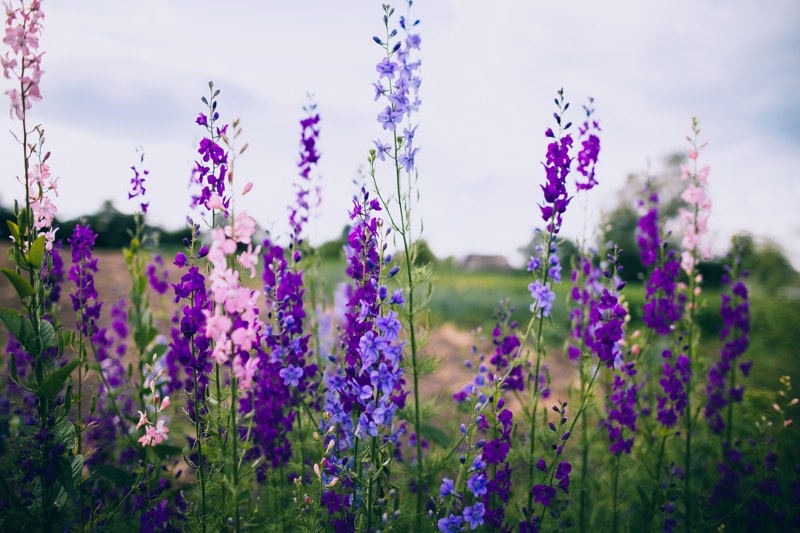
This flower is also commonly called larkspur, though when using this name, it’s important to avoid confusion with flowers from the Consolidate species.
Let’s start with the meaning of this flower before looking at the best way to grow your own.
Delphinium Flower Meaning
The plant gets its name from Greek—the ancient Greeks thought delphinium flowers looked like a dolphin.
This may not be apparent at first, but if you pick a bloom from the spike of the plant and look at it from the side, you’ll notice that it looks not unlike a leaping dolphin.
It’s also said that the plants look like the bottle-like nose of a dolphin.
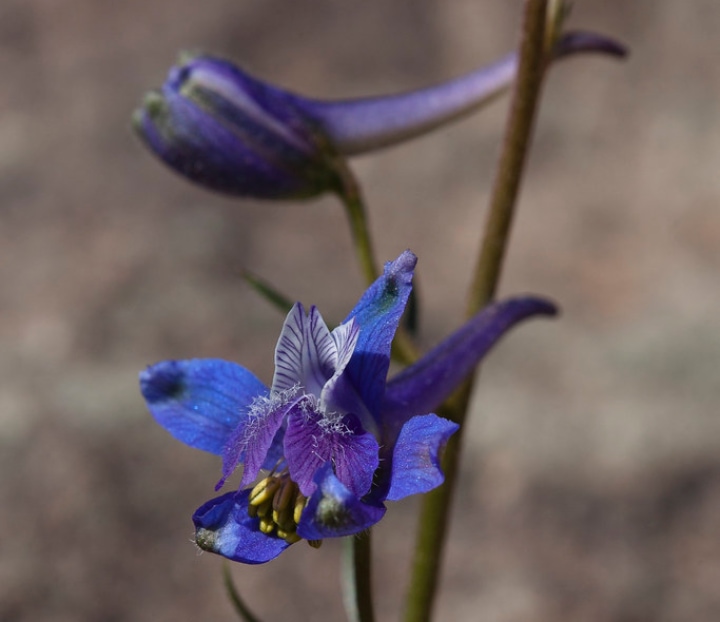
The delphinium appears in Greek legend. According to the myths of the Trojan Wars, the Greeks speak of a flower that grew from the spilled blood of the Greek hero Ajax.
After Achilles was killed in battle, his mother asked for his armor to be given to the most heroic Greek on the battlefield—it was given to Ulysses.
Feeling slighted, Ajax went in a rage and tried to kill Ulysses and others. But Athena intervened, and when Ajax came to himself, he was mortified and committed suicide using his sword.
Despite this legend, delphinium symbolizes protection—people used to pick these flowers and carry them for protection against scorpions.
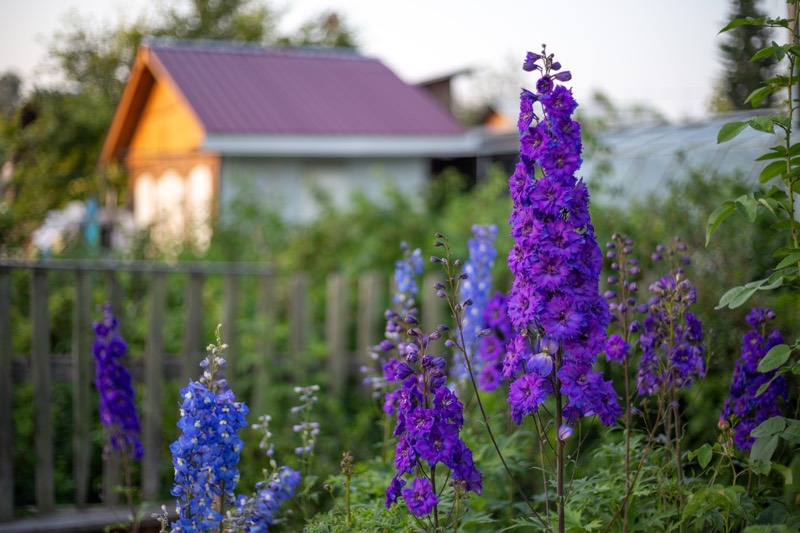
The delphinium plant has quite a few other meanings, some of which are not readily associated with other plants. Here are some of them:
- Striving for success and showing support for someone embarking on a new undertaking.
- Protection against danger and other mishaps.
- Openness to new emotions and people, including potential romantic partners.
- Enjoying life with all its pleasures and amusements despite hardships.
- Celebrating meaningful events and important accomplishments.
Delphinium is also considered the flower of the month of July, making it an excellent birthday flower for anyone born on this month.
Delphinium Colors Meaning
Delphinium is probably best known as a blue flower. But today it’s available in many other colors, and each carries its own layers of meaning.
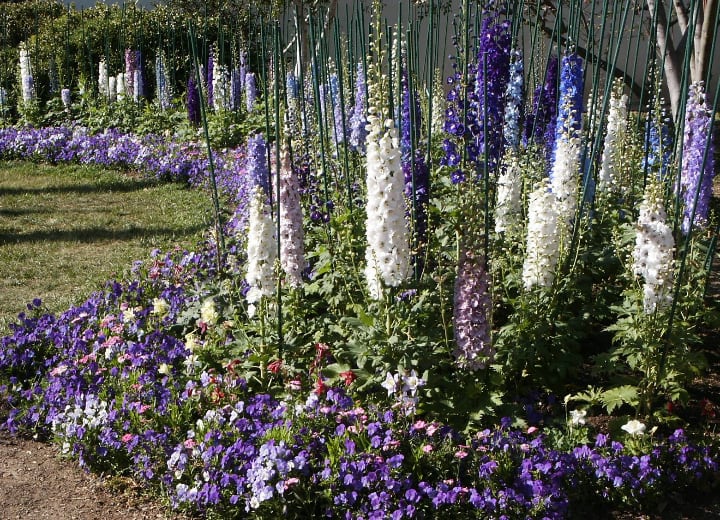
- Blue delphinium symbolizes trust and support. It’s sometimes planted as a way to remember a departed loved one.
- White delphinium conveys purity and innocence. It’s the most popular type of delphinium for baptism and wedding flower decorations and arrangements.
- Purple delphinium symbolizes royalty and can be a great gift for someone special in your life.
- Pink delphinium is most often associated with love, romance, and passion—it can be an alternative to roses on Valentine’s Day.
Delphinium Toxicity: A Word of Caution
We’re talking about a plant that’s highly toxic, especially the young growth and the seeds. This is because of the alkaloids it contains.
If you have small children, you may want to defer planting it until they grow older. Or plant them where your kids are not likely to come into contact with them.
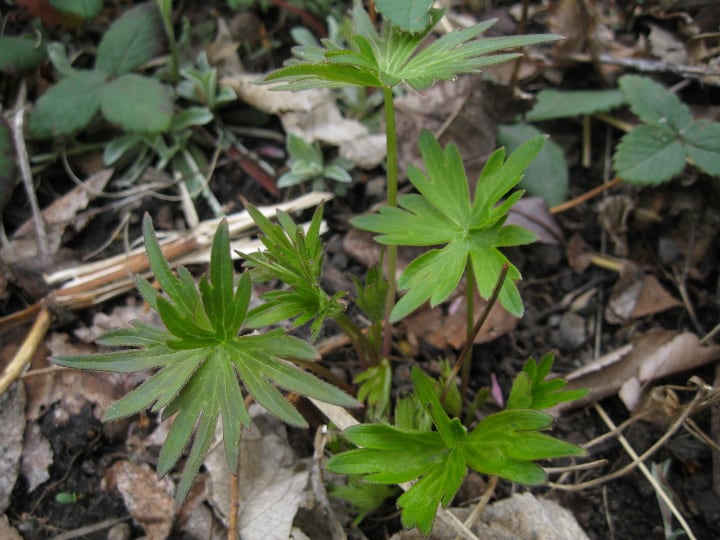
Ingesting the flowers, leaves, seeds, or stems of the plant can cause vomiting, muscle spasms, respiratory system problems, and convulsions. If touched, the plant may also cause severe skin irritation.
The plant is also toxic to dogs.
Types of Delphinium
Should you get an Elatum delphinium or a Belladonna delphinium? And what about other varieties? Let’s explore together the different varieties of this plant.
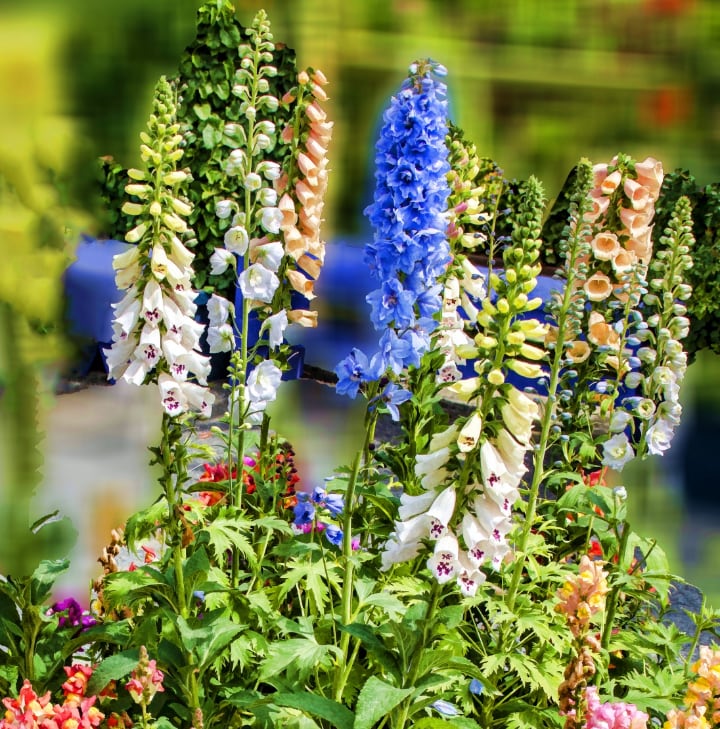
Delphinium Flower Groups
The best-known varieties fall into four major groups. Learning a bit about these groups can be useful before you start exploring specific varieties.
Elatum Delphiniums
These spiked hybrids exceed 6’ in height and can spread to 3’. They form into clumps and put on a rich display of flowers in early to mid-summer.
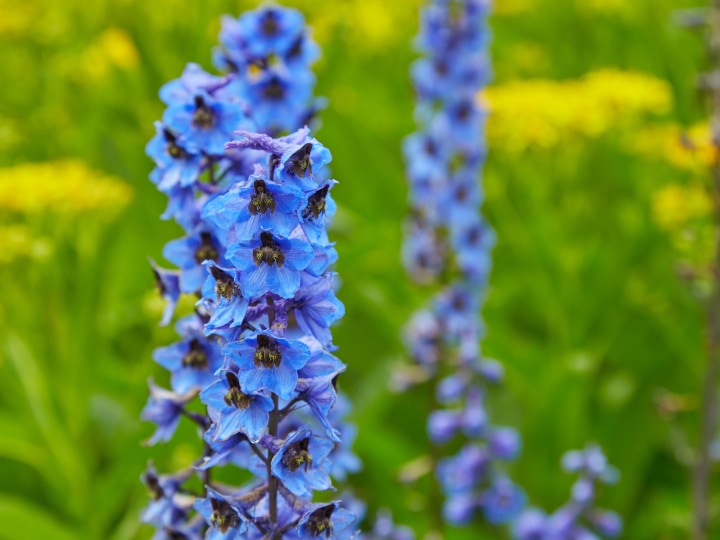
Good to know: Elatums are wonderful ornamentals, but they require very good soil and careful watering and fertilization to thrive.
The short-lived but bountiful blooms can be blue, purple, white, or pink. For most Elatum cultivars, staking is a must because of their height.
This group includes short and medium varieties as well, so make sure to explore all your options.
Belladonna Delphiniums
These are mostly loose and branching hybrids that grow up to 4’ tall. Most varieties wear shades of blue or white in spikes of single or double flowers.
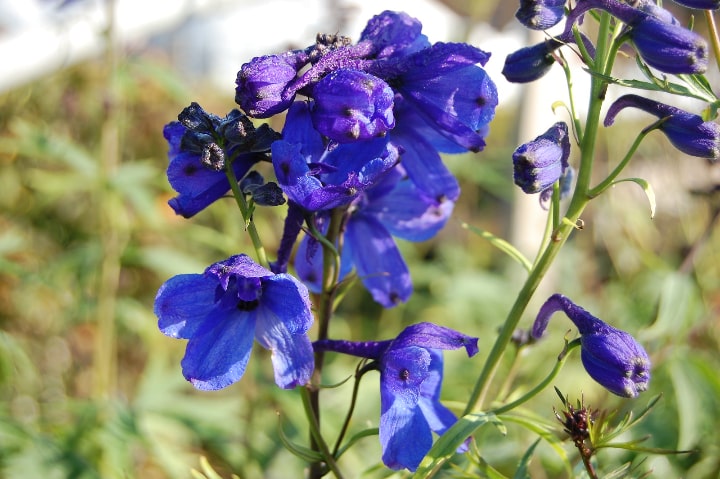
They bloom in early summer, which means you can cut their blooms to promote a second flowering in early fall.
Good to know: Flowers in this group tend to be easier to grow than Elatums.
Pacific Giant Delphiniums
Known for their columnar spikes, Pacific Giants bloom into single or double florets. They can reach 6’ in height.
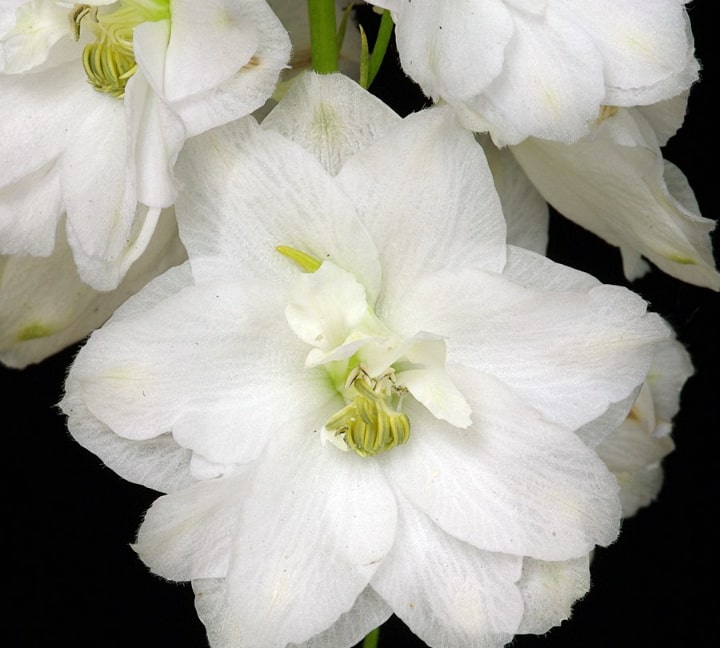
One reason to choose Pacific Giants is the wide range of colors they come in, including white, blue, purple, pink, and lavender.
Good to know: These delphiniums tend to be short-lived, but they make up for that with their gorgeous looks.
Delphinium Grandiflorum
Also known as Chinese or Siberian delphiniums, the plants in this category are short and bushy.
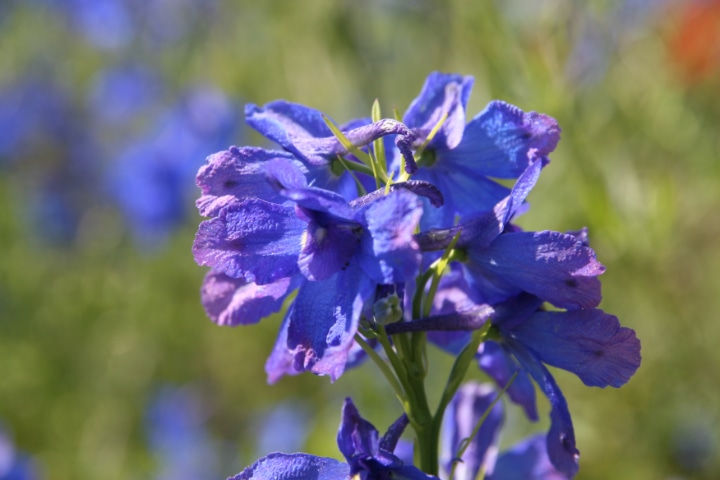
They carry splendid white or blue flowers that grow in a dispersed pattern. This feature, together with their height, differentiates them from other groups.
Notable Delphinium Flower Cultivars
We’ve seen the main plant groups, now let’s look at some specific cultivars. There are lots of beautiful options around—you’ve been warned!
1. Magic Fountain Delphinium
This cultivar stands out thanks to its majestic spikes of compact white flowers. A great ornamental, it towers over other plants from a height of up to 4’.
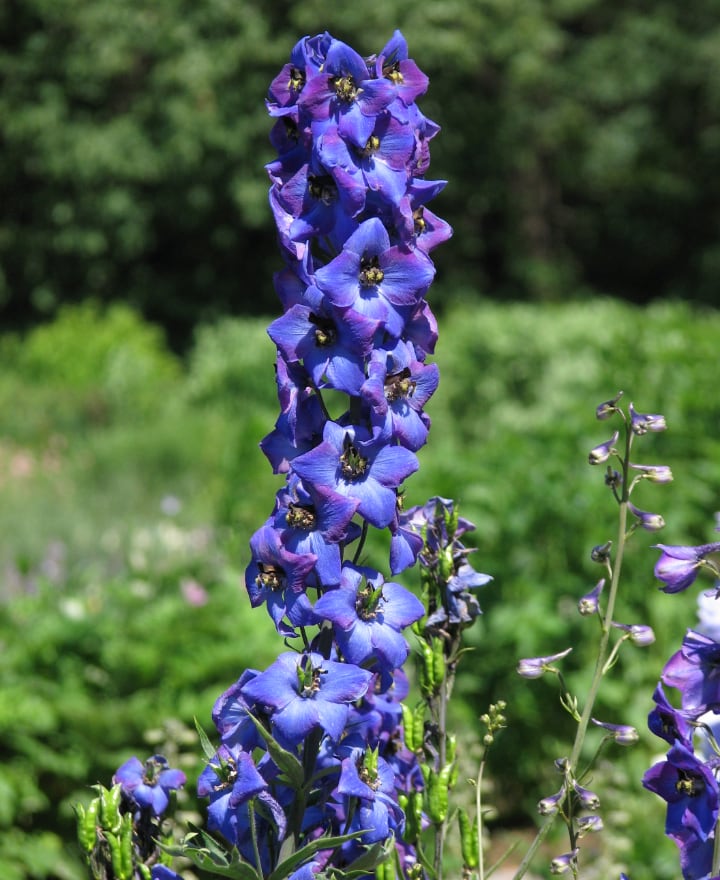
Tip: Despite its height, it does not usually require staking.
2. Butterball Delphinium
One of the most beautiful short varieties, Butterball has stately semi-double cream flowers that make the effort of growing it worthwhile.
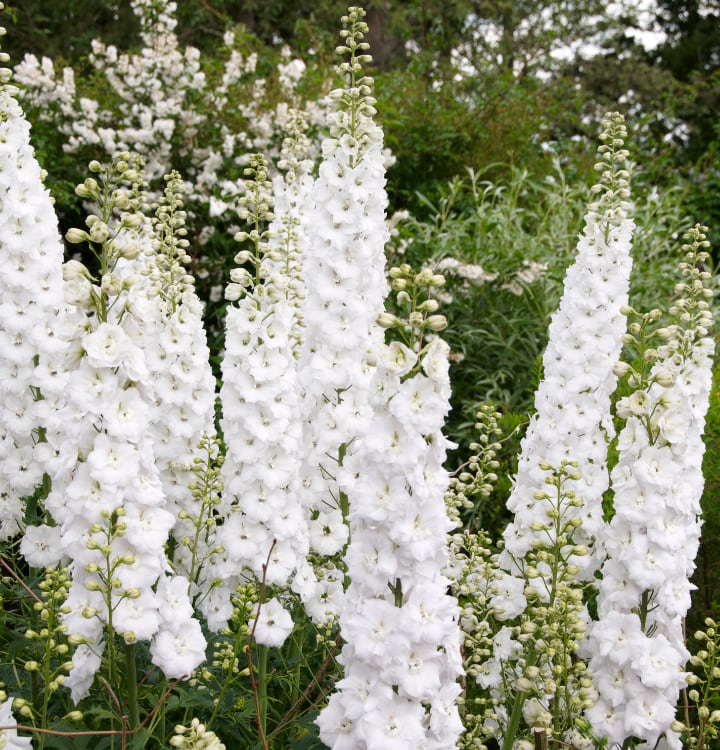
3. Blue Dawn Delphinium
Dark central petals give this popular variety a striking look. Pay close attention to the pale blue blooms and you’ll notice they bear a delicate pink tinge like a quiet blush.
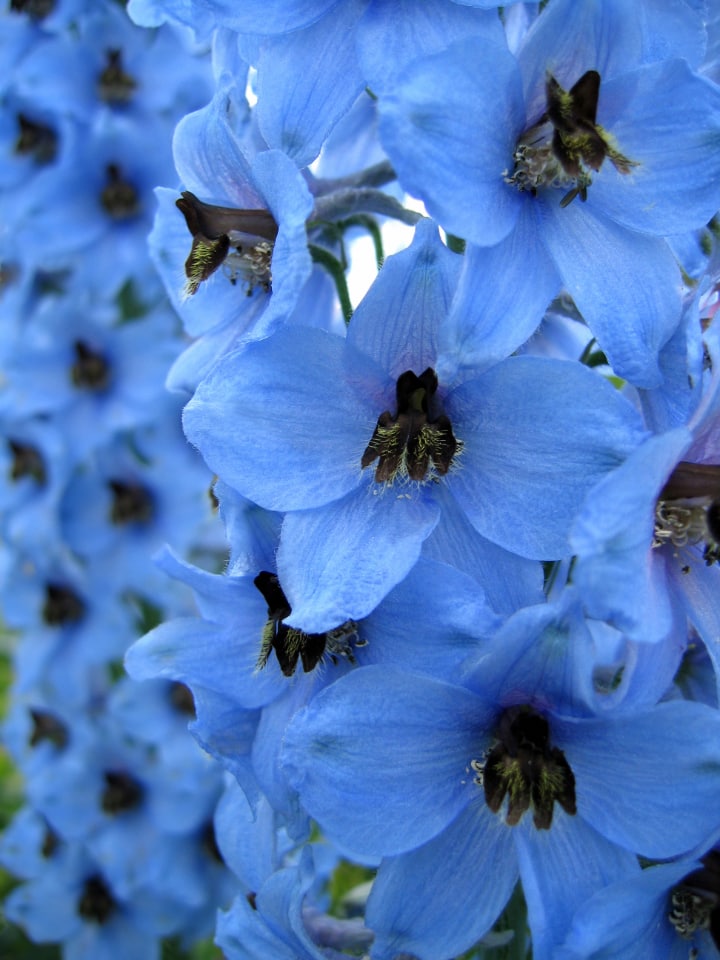
4. Turkish Delight Delphinium
A medium variety, this one has pink-violet flowers that contrast beautifully with the white centers.
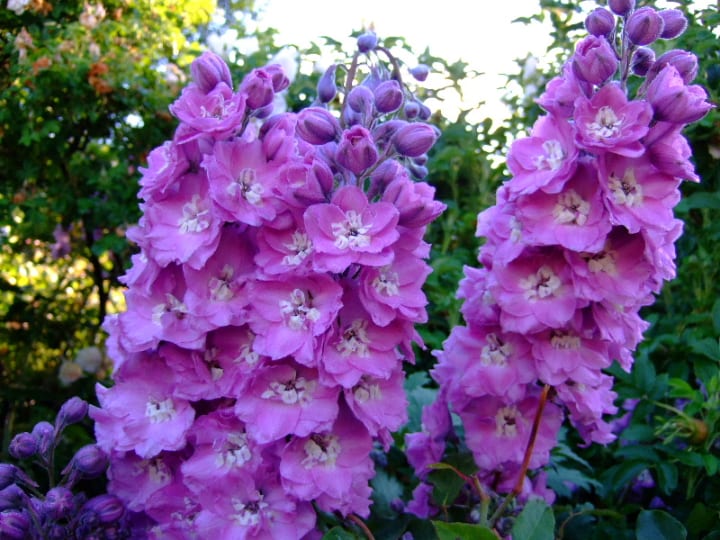
5. Mother of Pearl Delphinium
Who said delphiniums are afraid of wind? Well, some may be, but not this one. Mother of Pearl grows tall and bears semi-double pink or pale blue flowers and brown “bees”.
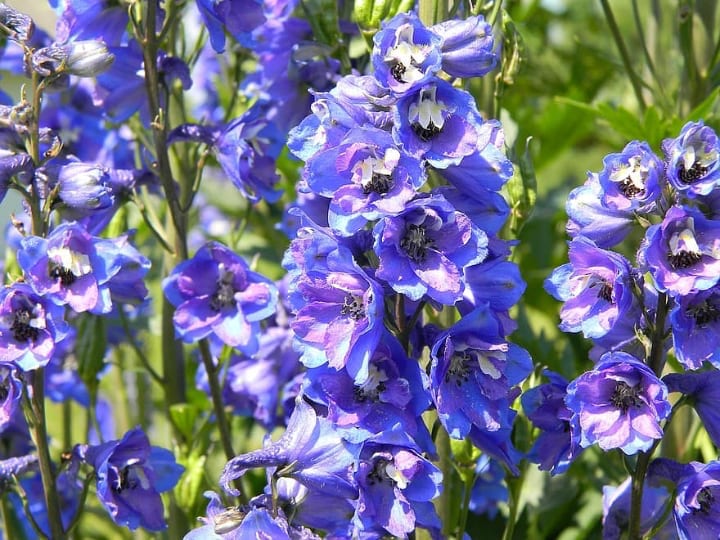
Did you know: Delphinium centers are also called “bees”. Not to be confused with buzzing bees!
6. Boningale Glory Delphinium
Another tall cultivar, Boningale Glory has delicately tinted inner petals and medium-blue blooms. It can grow over 6’.
7. Blue Nile Delphinium
A great example of the grace and beauty of medium-height delphiniums, Blue Nile bears bright mid-blue flowers with white bees.
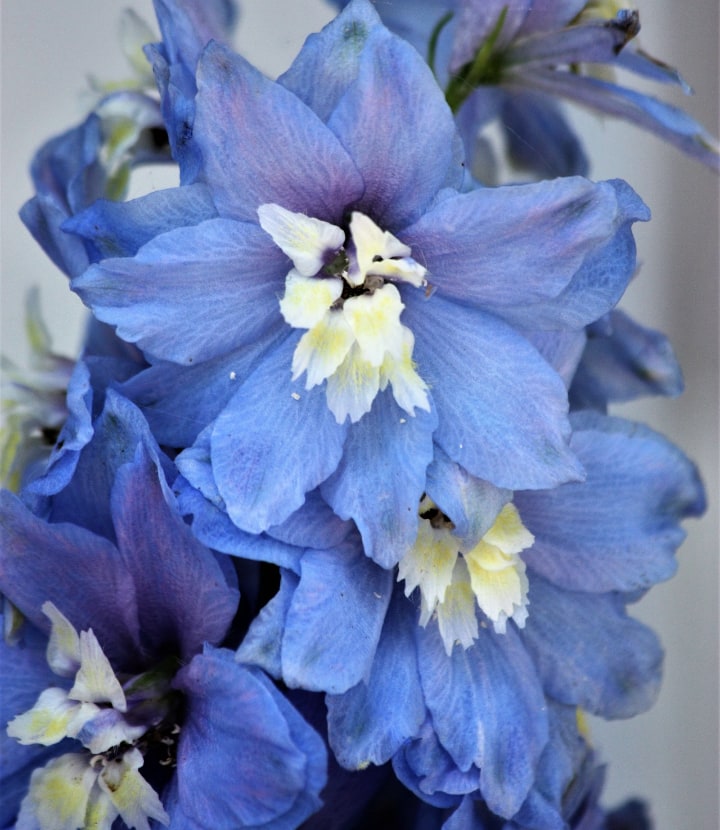
8. Bruce Delphinium
This Elatum delights the eye with its violet-purple flowers and brown bees. The flowers are usually semi-double.
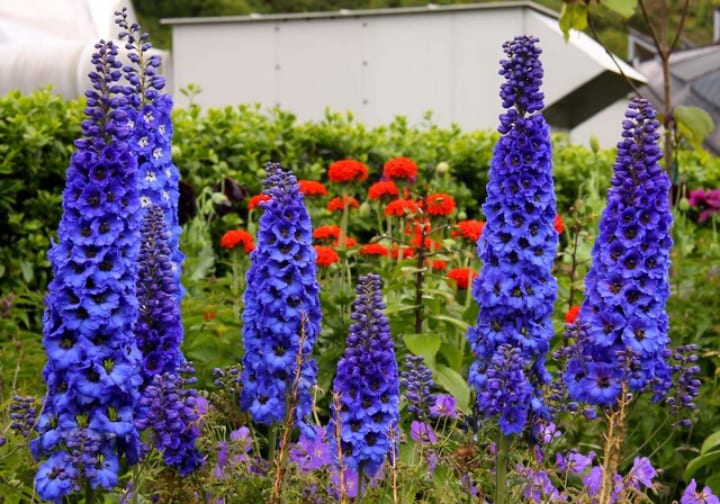
9. Blue Bees Delphinium
The name gives this one away—the clear blue flowers with their white centers are arguably the best reason to choose it over other varieties.
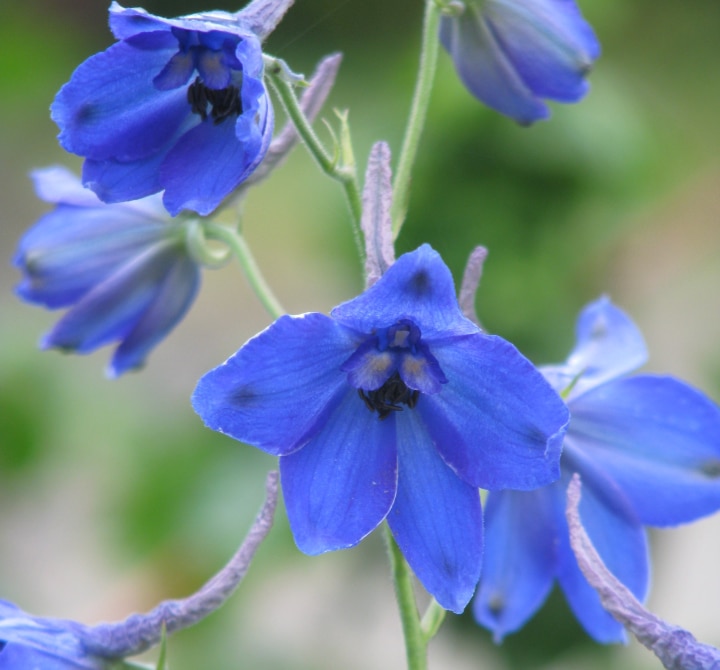
10. Black Knight Delphinium
A popular cultivar, Black Knight has rich green leaves and dark purple flowers. If you get this one, make sure to get some stakes too as it’s vulnerable to strong wind.
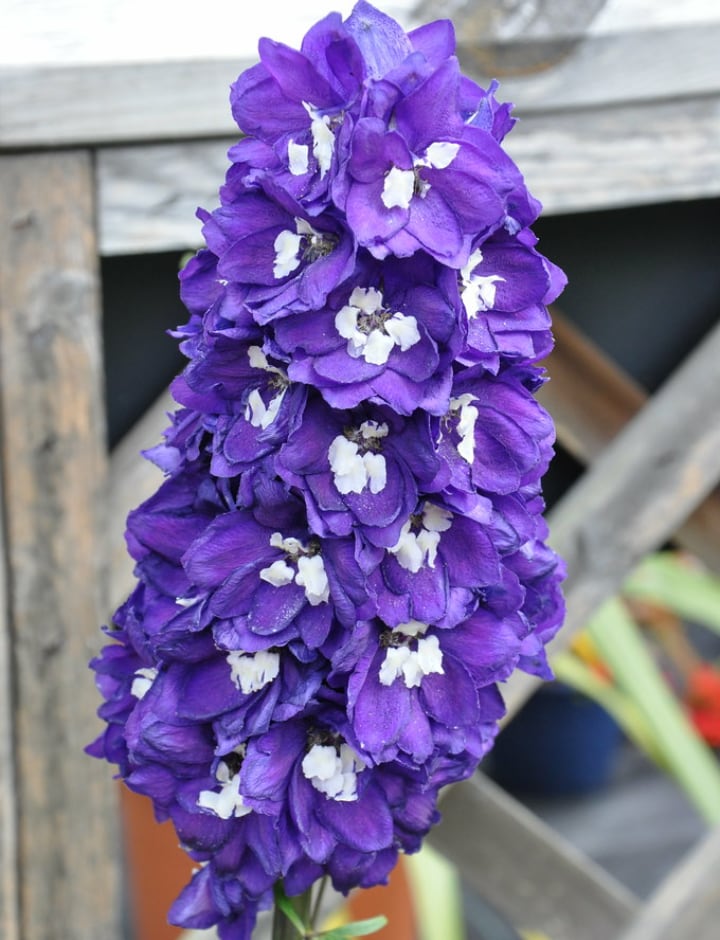
11. King Arthur Delphinium
This variety boasts medium-height spikes of plum-colored flowers. Its rather unusual color can attract attention in both minimalist and more sophisticated gardens.
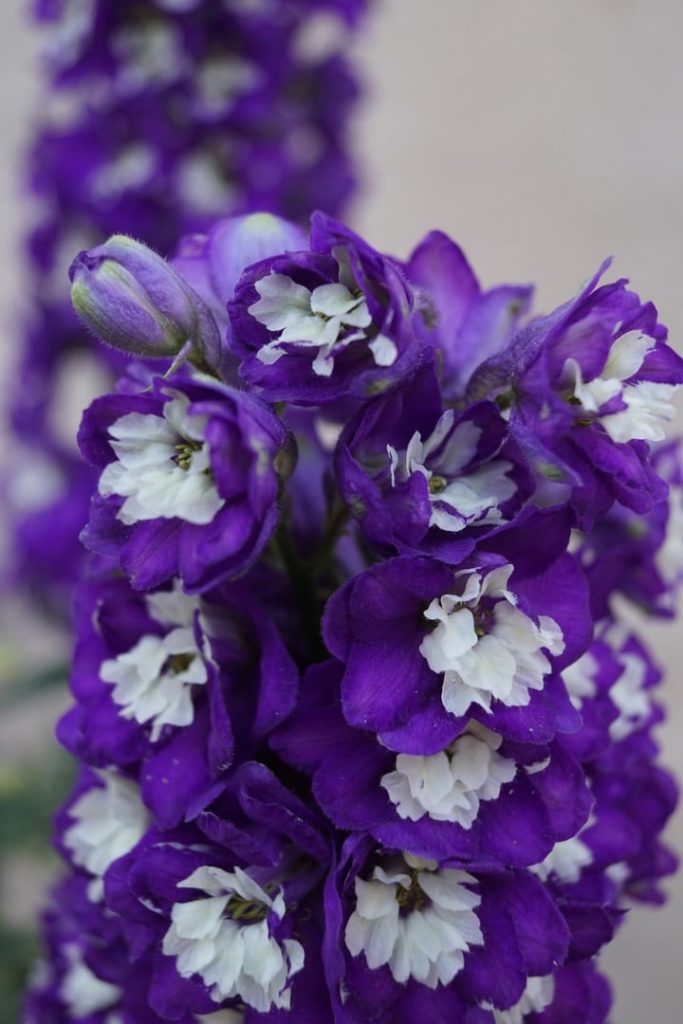
How to Grow Flowers from Delphinium Seeds
Growing this plant from seeds takes a bit of time but isn’t all that hard. It’s important to buy fresh seeds—that alone can make a big difference.
Another important consideration is the temperature—delphinium seeds germinate best around 60-68°F (15-20°C).
Here are some more tips to help you out.
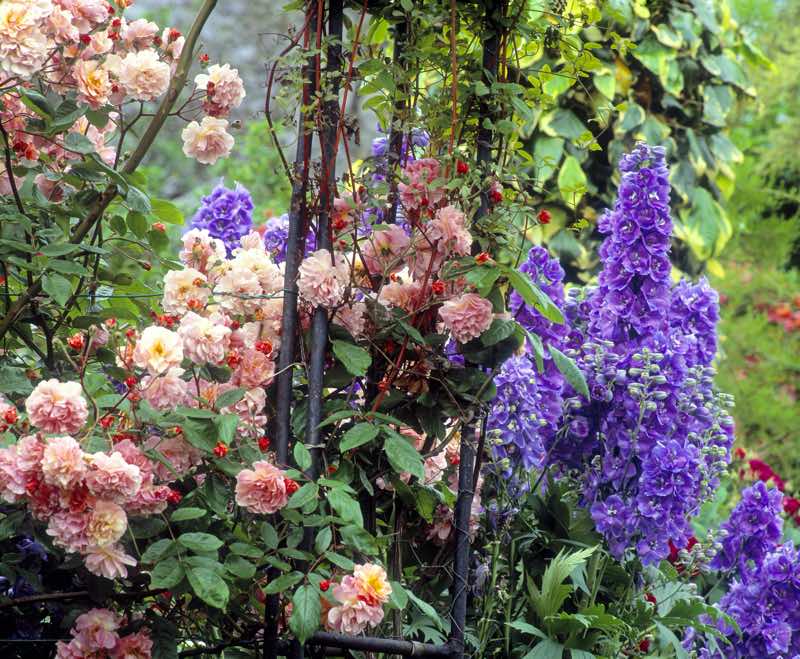
- Sow the seeds indoors around 10 weeks before the last spring frost.
- Plant the seeds in a mixture of peat moss, perlite, and vermiculite at the ratio 1:1:3 in slightly acidic soil. Make sure to keep the seeds covered until the root emerges.
- You want to let the seedlings grow before you move them to the garden. The seeds should germinate within 2 weeks or earlier.
- Plant them in late summer or early fall. Make sure they have their own dedicated patch of ground free from weeds and other plants that may steal their nutrients.
- Water often to keep the ground moist but don’t overfertilize.
How to Pot Delphiniums
These flowers grow better in the garden, where their roots can spread out. But you can still grow them in a container without much fuss.
The thing to remember when growing this plant in a container is that you have to divide it as soon as it gets big.
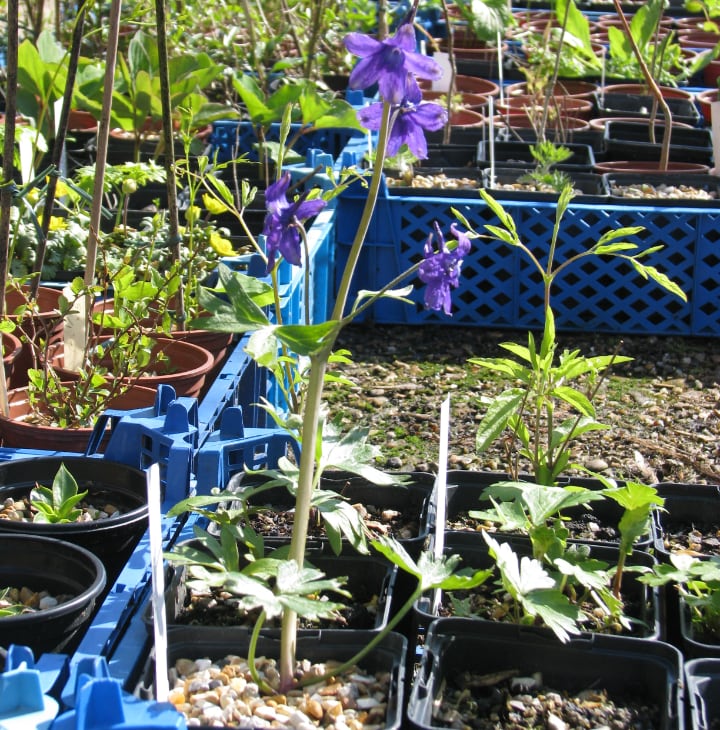
Also, delphiniums grown in containers need to winter indoors. Leaving them outside during the cold almost always leads to irreversible root damage.
Step 1 – Pick the Right Container
Choose a large container that retains moisture. You may have to cover the drain hole with fine gravel. Also, make sure the soil at the bottom of the pot is moist.
Step 2 – Mix the Soil
Add soil that provides good drainage while also holding water and nutrients. Use one part peat, one part organic soil, and one part perlite or an organic soil-less mix. Once again, the soil is crucial, so make sure you get this part right!
Step 3 – Move the Plant
Transplant the plant from the nursery container into the pot when it’s dormant, which is usually in early spring. The top of the roots should be just above the soil level.
Step 4 – Support the Plant
Use a few small bamboo stakes to form a triangular support for the plant. Even in a pot, larkspurs can grow quite tall. The support will ensure they grow healthy.
Step 5 – Water and Fertilize
Water well and apply a liquid 12:10:10 fertilizer every two weeks. Last but not least, keep the plant by a window where it will get at least 5 hours of sunlight every day.
Step 6 – Place It in the Right Spot
Keep the plant by a window where it will get at least 5 hours of sunlight every day.
Important: Your newly planted delphinium can stay in its current pot for up to 5 years. After that, it’s best to move it into the garden.
Care for Delphinium Plants
Some gardeners struggle to grow these plants. Probably the most common reason for this is that they apply to them more or less the same growing approach they use with other plants.
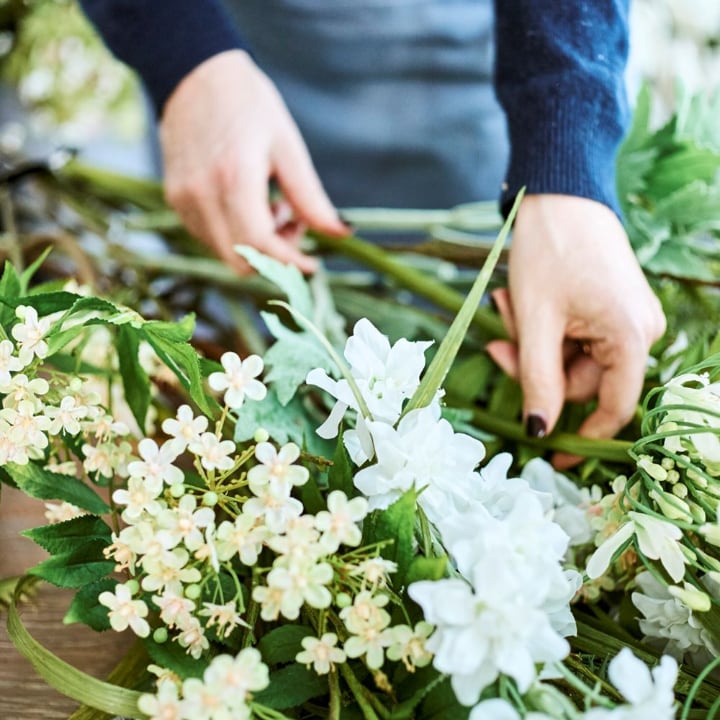
You’re looking at a plant that’s particular about the soil, the amount of sun it needs, and how often it should be watered. If you get these things right, growing these lovely plants won’t be hard.
Soil
These flowers are rather picky when it comes to soil. The best soil for them is rich in humus and slightly alkaline. You’ll have a hard time growing these flowers in non-fertile soil.
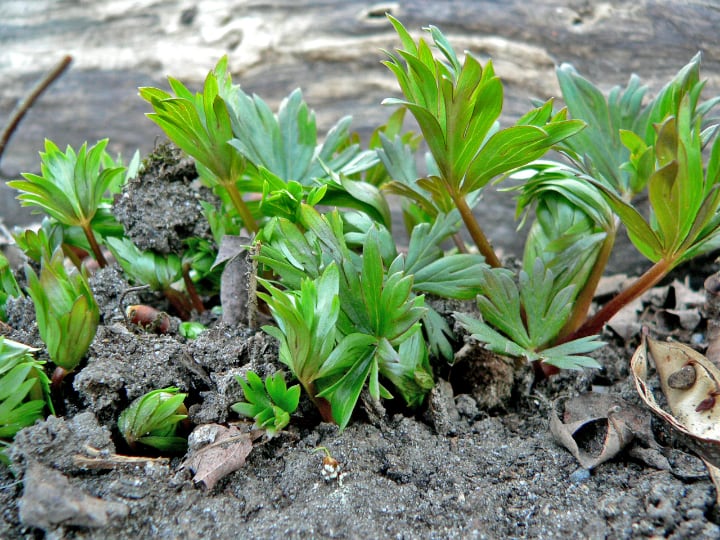
So, take the time to prepare the ground before you plant them. The delicate beauty of the flower is well worth the effort!
Tip: Talking of planting, it’s also important to make sure that the top of the root ball is level with the earth.
Light
Delphinium flowers love the sun. One of the main reasons why people are having difficulties growing them is poor placement.
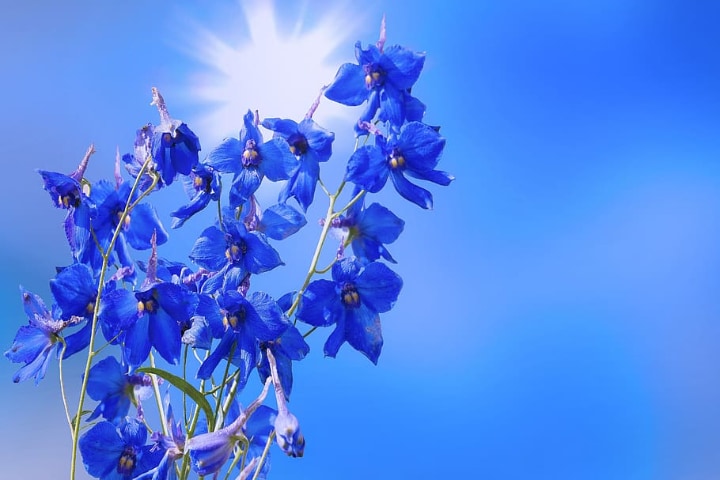
Most varieties require at least 6 hours of sun every day, and preferably 8 hours. But keep in mind that the roots shouldn’t be exposed to the sun—they do best in moist shade.
Temperature
This flower needs temperatures over 60-35°F (15-18°C) during the day to produce lots of flowers. At lower temperatures, the plant may not flower profusely.
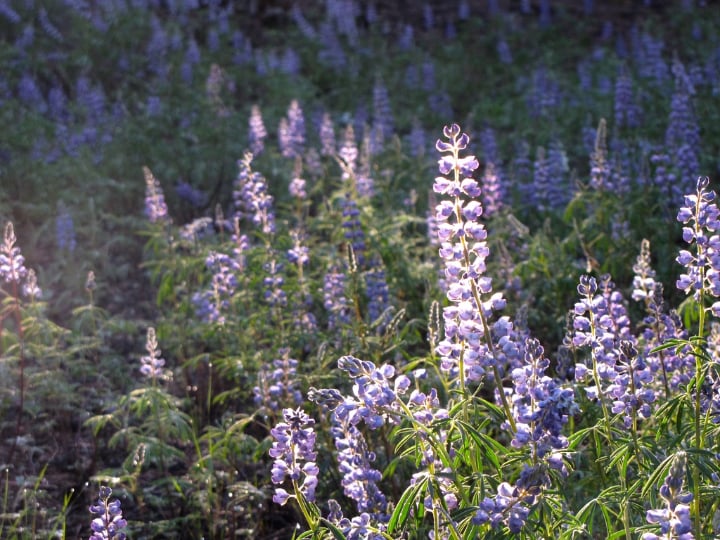
At night, it needs temperatures above 55-60°F (13-15°C).
Watering
Don’t let the soil dry out completely. Water your flower freely while it’s growing.
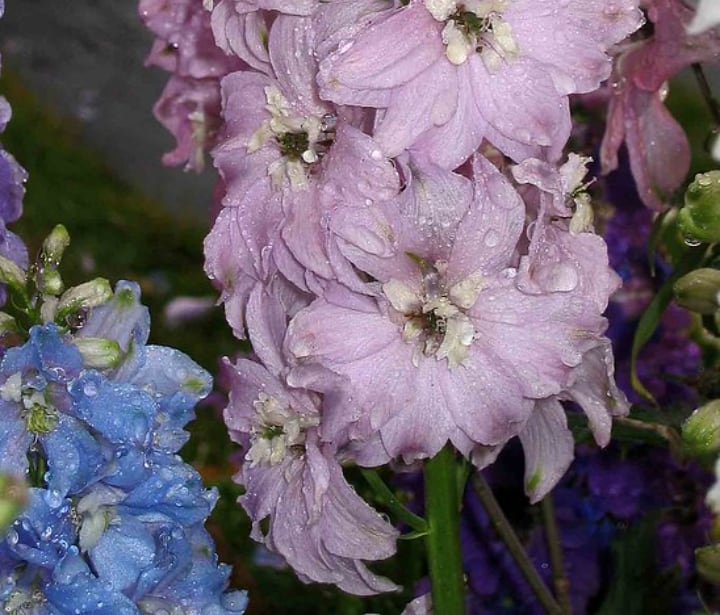
If it doesn’t rain much during the summer, keep watering the plant to ensure it stays healthy.
Fertilizer
Like most plants, these flowers like a bit of fertilization now and then. Apply a balanced fertilizer every 2 weeks while they are growing. Careful not to overfertilize!
Deadheading
By deadheading your delphinium in early summer, you can encourage a blast of gorgeous blooms in late summer or early fall.
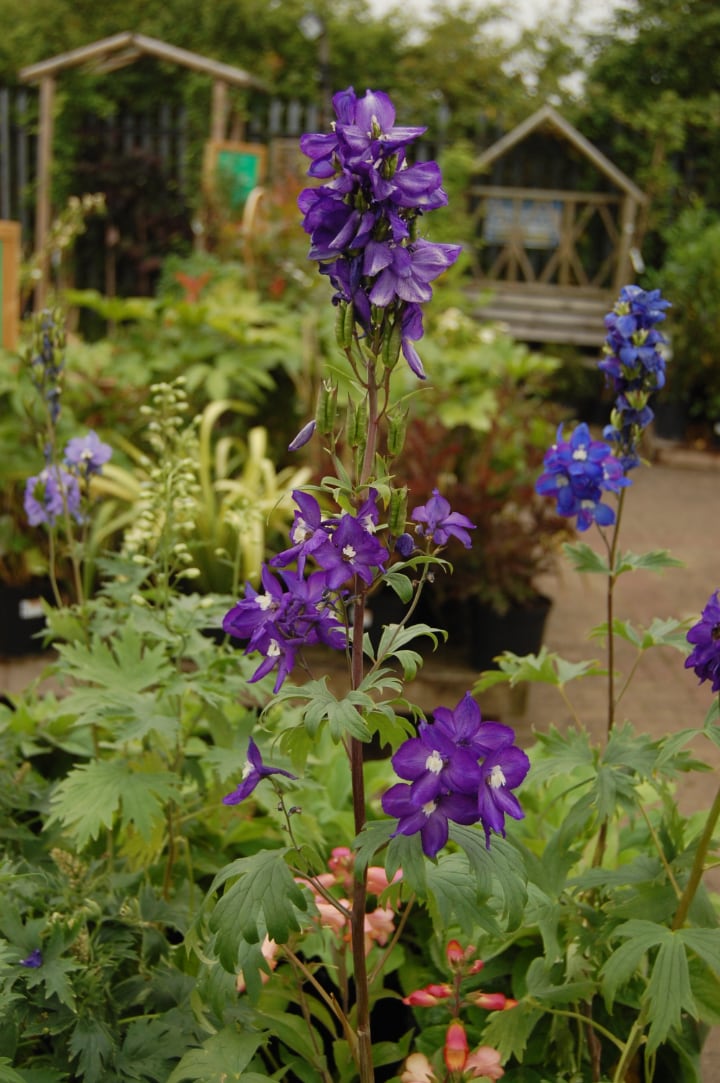
You want to deadhead the first blooms as soon as they are spent. After deadheading, add fertilizer to the plant and water enough so that the ground stays slightly moist but not damp.
The second blooms are the most beautiful of the year and will put on a magnificent show in your garden.
Support
Since these flowers can grow quite tall, it helps to support them with stakes or other easy-to-install supports. This will prevent damage from wind or heavy rain.
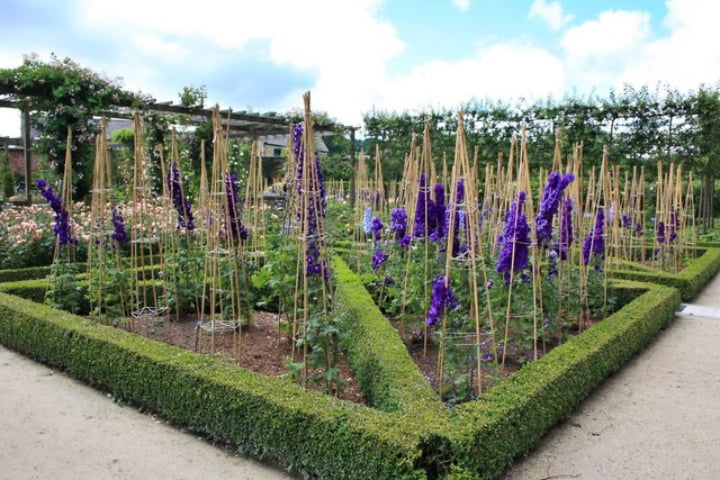
Tip: You want to add the supports when the plant reaches about 12” in height, which is usually about mid-spring. As a rule, the taller your plant, the sturdier should the stalks be.
Delphinium Flowers Frequently Asked Questions
We keep hearing the same questions about these plants over and over again. To clarify things once and for all, here are the answers to the most common questions about this plant.
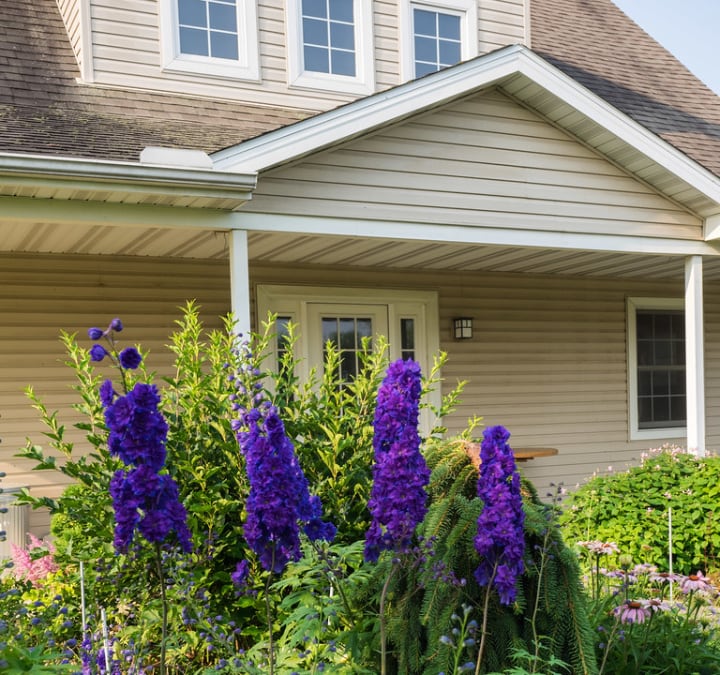
Do delphiniums come back every year?
Most delphinium plants are perennials that come back to life every year. But some varieties can be annuals or biennials, which is why it’s important to check when buying that you’re getting the right variety for you.
Do delphiniums like sun or shade?
Delphiniums grow best in full sun to light shade. They need plenty of sun to mature into healthy and colorful plants. Avoid planting them in a spot where they get too much shade.
Are delphiniums hard to grow?
Delphiniums can be more demanding than other plants in terms of soil and care but growing them doesn’t have to be difficult. If you follow the specific plant care tips that come with your chosen variety, you’ll grow beautiful plants without any hassle.
How do you take care of delphiniums in the winter?
Cut down the stalk of your delphinium plants to about 6” of their height after the first frost or in early spring and then add mulch. If your delphinium is a perennial, you don’t have to dig out the roots and cool them unless very high winter temperatures will prevent it from going dormant.
Dolphins in Your Garden!?
Maybe not, but delphiniums—a big Yes! Not everyone grows these plants—whether it’s because of their toxicity or because many gardeners assume they are hard to grow.
But taking the trouble to understand how to grow and care for these flowers can be rewarding.
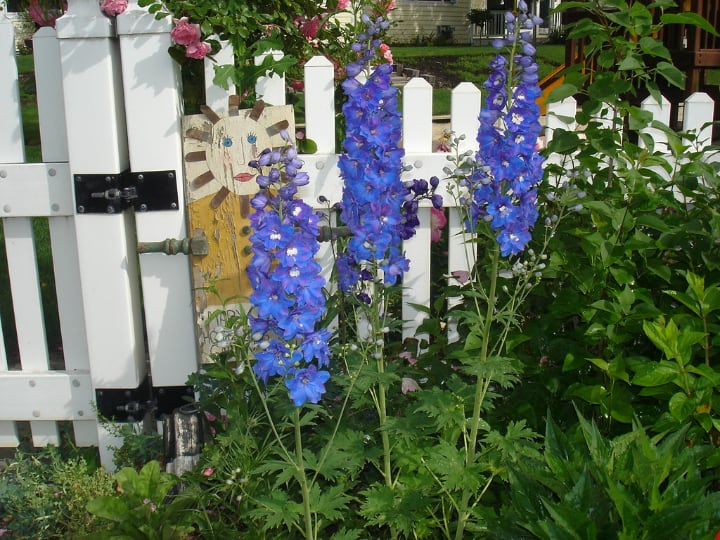
They can add richness to your garden palette of colors and, thanks to their often-towering growth, take the center stage in any flower design.
But at the same time, they’re also great for hiding walls and other unsightly garden structures.
We hope that by now you’re no longer on the fence about growing these plants. Now why don’t you roll up your sleeves and get to work planting some?
And then come back and tell us how it went? We’d love to hear about your gardening adventures.

Leave a Reply